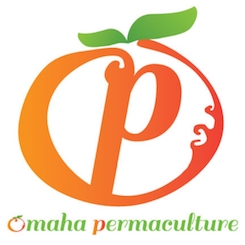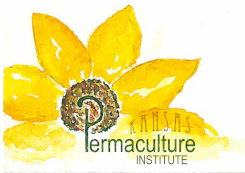Este fue el primer diseño que implementamos en Interdependent Web Urban Farm. Como tal, necesitaba producir un rendimiento el primer año, incluso mientras mirábamos hacia los años futuros. Por esta razón, diseñamos una plantación sucesiva: plantamos todo a la vez y dejamos que algunos cultivos murieran cada año y fueran reemplazados por las plantas perennes que maduran gradualmente. La ubicación está cuesta abajo de la mayor parte de nuestro jardín y del de los vecinos, por lo que necesita lidiar con un suelo muy húmedo. Y como plantación en el patio delantero, también tiene que ser razonablemente atractiva.
El objetivo a largo plazo es tener un gremio del peral: la plantación estará dominada por un peral rodeado de plantas que lo sostengan. Sin embargo, el árbol tardará muchos años en alcanzar la madurez, por lo que, mientras tanto, estamos cultivando otros cultivos en el mismo sitio. Esto se complica por su proximidad al gremio de nogal negro: algunos de los cultivos se vuelven menos productivos a medida que las raíces tóxicas del nogal los invaden.
Álbum de fotos de esta ubicación
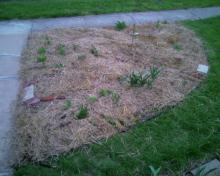
El primer año (2009), la parcela estuvo dominada por cultivos anuales: amaranto, rúcula, pak choi bebé, albahaca, brócoli, acelga, rábano, diente de león, equinácea, edamame (soja verde), ajo, col rizada, colinabo, cenizo, lechuga, orégano, guisantes, patatas, rábanos, espinacas, tifón, violeta, acedera. Algunas plantas perennes también produjeron un cultivo el primer año: cebollino, consuelda, iris, menta, cebollas, perejil, fresas. El trébol formó una cubierta vegetal perenne y fijador de nitrógeno.
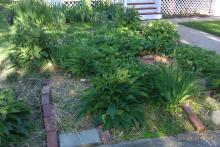
El segundo año (2010), las únicas plantas anuales que quedaron fueron las que se autosembraron: amaranto, rúcula, diente de león, cenizo, tifón, violeta y acedera. Las plantas perennes que debutaron este año fueron camas y frambuesas rojas.
El tercer año (2011), la parcela estaba dominada por frambuesas, fresas, menta, consuelda y cebollas. Continuamos intercalando edamame y tifón en todos los huecos disponibles.
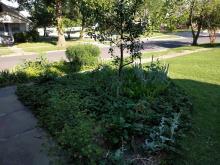
En los años siguientes, la parcela estaba dominada por fresas y menta, y las frambuesas se redujeron a una sola planta en 2017. El peral produjo sus primeras flores en 2016 y su primera pera en 2017. En algún momento del proceso plantamos un poco de rábano picante, una mala idea, ya que cosecharlo significa perturbar las raíces del árbol y, sin cosecharlo, ¡se propaga!

